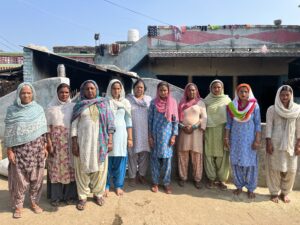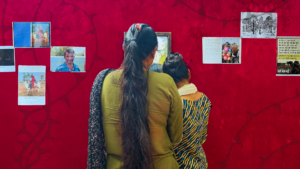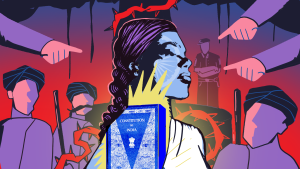Why Justice Remains Elusive For Adivasi Victims Of Sexual Violence

In 2017, a 15-year-old Adivasi student in Odisha’s Cuttack district was raped by a group of men wearing police uniforms as she was returning from the local market where she had gone to get some photos. Immediately, she went to the police station and filed an FIR.
Justice for her ended there. She could not identify her attackers beyond the fact that they were in police uniforms. And the police, instead of trying to find the perpetrators, threatened a witness and warned the other villagers to keep quiet, according to local activists.
Further, despite the teen’s vehement claims, the medical examination report ruled out rape. And she did not receive the necessary psychological support, an integral part of the Indian government’s guidelines for providing medico-legal care for survivors of sexual violence. The trauma was such that a year later she killed herself.
It took another three years of persistent effort from an activist to secure legal aid for her parents, who are daily wage workers. They were even denied copies of the medical report.
This case highlights the many forms of violence that Adivasi women and girls face in India as well as the systemic barriers to accessing justice in its aftermath. A new report titled ‘Beyond Rape: Examining The Systemic Oppression Leading To Sexual Violence Against Adivasi Women’ has been published by the National Council of Women Leaders (NCWL), a national body working at uniting women and transwomen leaders from marginalised communities. The report analysed 32 instances of sexual violence in 10 states of of Assam, Bihar, Chhattisgarh, Gujarat, Jharkhand, Maharashtra, Manipur, Madhya Pradesh, Odisha, West Bengal. These are states with significant indigenous populations.
Poverty, marginalisation and stereotyping of Adivasi women as “promiscuous” and “sexually available” has increased the risks of violence against them, said the report. Moreover, resource exploitation, dispossession and increased military presence has compounded vulnerabilities for women living in “Left Wing Extremism” affected areas and in conflict areas like Manipur. According to the Ministry of Home Affairs (MHA), Left Wing Extremism is the Maoist insurgency that “glorifies violence as the primary means to overwhelm the existing socio-economic and political structures”.
At every stage of seeking justice, Adivasi women have to deal with violation of their agency and rights, making access to justice increasingly difficult, the report said. For instance, in seven of the 31 cases, no FIRs have been lodged and in all of them, the perpetrators were police or security officials. In the cases where FIRs were filed, it was a delayed process, taking as long as a year in some cases. And in most of these cases, the FIRs were filed only after activists and collectives put pressure on the police.
Despite the Supreme Court banning the two finger test, in almost half (15) of the cases, the survivors were made to undergo it. Moreover, the medical examination was not conducted in eight cases and in several cases, it was so delayed that a lot of the forensic evidence was lost. Besides, there was no attempt made by the police to support and counsel the survivors.
Access to justice is unequal and it largely eludes women and queer people from marginalised communities (here, here, here). In our series, “Violence,Marginality and Justice”, Behanbox records and reports on the many structures – social, political, administrative and legal – that perpetuate gender-based violence and access to justice.
Violence In Educational Institutions
In almost half (15) of the 33 cases documented in the NCWL report, the victims or survivors were children and in some cases, the assault took place in educational institutions.
In Maharashtra’s predominantly tribal district of Gadchiroli, the warden of an ashramshala – a government-sponsored hostel cum school for tribal girls – drugged at least 19 students by giving them a drink that he claimed was an Oral Rehydration Solution. At night, she gave them a pill that made them unconscious, and then raped them. The warden, who belongs to a dominant caste community, carried on with this for two months. The students were unaware of what happened to them, except that they found themselves unclothed in the morning.
“This is the case in an ashramshala, where the state is supposed to be the protector of the girls. They are supposed to educate them, they are supposed to be responsible,” said Shewli Kumar, the author of the report and assistant professor at the Tata Institute of Social Sciences (TISS) Mumbai. “People who are not from Adivasi communities have a warped idea of those from the community and this case is illustrative of how these stereotypes systematically percolate into the minds of the government office-bearers and they become the violators.”
In a similar incident in Assam’s Jorhat, a 14-year-old student from the Tuli tribe was sexually harassed by her teacher. He asked her to unbutton her frock in front of the entire classroom while making a sexual innuendo about breasts. When she covered her breasts with her hands over her uniform, the teacher tried to pull her hands away.
Scared and humiliated, the young student could not speak up and her father only found out about the incident through a colleague. When the teacher was asked to explain his actions, he admitted to the innuendos but denied pulling her hands away. Citing harm to the school’s “reputation”, the three men decided to drop the issue
After the incident, the girl’s attendance dropped, and finally she stopped going to school. On the day of Dashami during Durga Puja, she killed herself.
During her fieldwork, several Adivasi girl students from government middle and high schools told PhD researcher Rashmi Kumar that they fear their male school teachers, older brothers, fathers and sometimes uncles.
Violence in schools instils fear and feelings of shame in children and reduces their motivation for learning, a 2016 desk review by UNICEF called Violence Against Children In Education Settings In South Asia found. The report citing an earlier UNICEF report also said that Dalit and Adivasi girls are more vulnerable than other schoolgirls to bullying and verbal abuse.
Subversion Of Due Process
Access to justice is particularly harder for women from marginalised communities and this is compounded by underlying prejudices stemming from past histories of criminalisation that stereotype women from these communities, according to the report.
In another incident from Gadchiroli, in 2017, local policemen abducted two women who were sisters-in-law as they were walking through the forest, who held them captive and repeatedly gangraped them. Then they gave the survivors money and asked them to keep quiet.
Despite help from activists, the two women have been unable to get any redressal and they continue to face threats from the police. As we had reported in this story, historically criminalised communities like NT DNT are not only always doubted when they go to report sexual violence but resources and support mandated by the state are unavailable to them.
“Everybody is entitled to get an FIR filed if they face such violence. The police cannot evade or delay it,” said Shewli. “The police believe that ‘such women’ should not be coming to the station and they dismiss their complaints as lies.”
This creates impunity and is reminiscent of the prejudiced ideas underlying the judgement in the Mathura case of 1972. That year, a police constable raped a 16-year-old Gond tribal girl at the Desaiganj police station in Maharashtra’s Gadchiroli, while another sexually harassed her. The Bombay High Court convicted the perpetrators only for the Supreme Court to overturn the verdict in 1978.
The judgement called the survivor “habituated to sexual intercourse” and echoed the sessions court verdict that had called her a “shocking liar” and that her testimony “is riddled with falsehood and improbabilities”.
These prejudices make each stage of seeking justice a space of violence for Adivasi women. In May 2013, the Supreme Court had banned the two-finger test, a scientifically inaccurate and patriarchal practice where two fingers are inserted into the survivor’s vagina to check if the hymen is intact. The court called the test invasive, regressive without any scientific basis. Yet, in almost half of the cases analysed in the report, the test was performed.
The 2014 medico-legal guideline also eliminates the test. But only nine states had adopted the guidelines, Human Rights Watch found in 2018. And medical professionals, even in the states that had adopted the guidelines, do not follow them. In Rajasthan, the standard form had a column seeking information about the status of the hymen and the doctors performed the two-finger test to fill it, said the report.
“A lot of the victims and survivors were not medically examined,” said Shewli. “And when the medical examination was done, they used the two-finger test.”
When State Is Complicit
While accessing justice is incredibly difficult for Adivasi women, the barriers compound when the perpetrators are police or security personnel. In such cases, the authorities resort to “protecting their own” instead of creating a safe space for the survivors or victims, said the report. The situation is worse in conflict zones and areas that have a special notification where law enforcers have more impunity.
In Manipur, where ethnic conflict has been ongoing since May 2023, a Kuki woman, her Meitei husband and their son fled from their burning village to the closest Meitei relief camp. When the people in the camp found out that she was Kuki, the Manipur Police Commandos came in large numbers and dragged her out to a nearby paddy field and raped and killed her, said the report.
The woman’s family had not been able to see her body as they were told that some miscreants had taken it away. An FIR was registered soon but it does not mention that the accused belonged to the Manipur Police Commando and sections pertaining to rape were not invoked.
Similar impunity is prevalent in Chhattisgarh where almost half (15) of the 33 districts have been classified as “Left Wing Extremism” affected districts. In these districts, the central government provides grants and paramilitary support to the states to fight the Maoist insurgency.
The insurgency, with its genesis in the Naxalbari farmers rebellion, was rooted in the fight against exploitation of forest and resources by private and multinational mining companies, as we had reported. In mid-2000s, when the insurgency was dominant in 200 districts across 12 states, the Indian government amped up the anti-insurgency efforts.
The militarisation that ensued led to the death of more than 2,000 Adivasi civilians and also exposed Adivasi women and girls to sexual violence. “Violence against women has increased, and any protest, collective mobilisation and efforts to seek redressal are met with sexual violence, capture and incarceration by police officials,” said the NCWL report.
Of the seven cases from Chhattisgarh that were analysed in the report, five were cases of gangrape by police personnel and District Reserve Guard (DRG). The DRG, which was initially set up in 2008 is composed of young tribal men and “surrendered Naxals”.
In one of the five cases, the personnel cut off the victim’s breasts, and violated and mutilated her private parts. She died during the assault. In another case, the victim died of suicide due to the trauma of the assault. In all the cases, the police and the administration refused to take cognisance of the crimes, instead labelling the women as ‘Naxalites’.
In the southern Chhattisgarh’s Bastar region, the anti-insurgency efforts have amped up since the BJP government came into power in the state in December 2023. Over 140 ‘Maoists’ have been killed in 38 encounters, the highest since the state’s formation in 2000. But not all those killed are Maoists. In one of the biggest encounters held on April 2, one of the 13 killed was a young deaf woman who was dragged from her home, Behanbox had reported.
“It is a manifestation of the Salwa Judum ideology where young people are co-opted and trained to fight the Naxalites,” said Shewli. “They are really aggressive and hypersexuality and toxic masculinity is promoted in the training process. So in one way, you are training them to violate and allow such violations to happen to women and girls from their own communities.”
The NCWL report highlights the need for ensuring economic, social and cultural rights of Adivasi women and ensuring their safety and security. Implementing existing laws, stopping militarisation, immediate police reform to improve accountability and sensitivity. It also demands that Adivasi women be empowered to participate in decision making on the use and control of natural resources.
We believe everyone deserves equal access to accurate news. Support from our readers enables us to keep our journalism open and free for everyone, all over the world.




